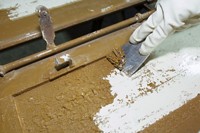Advertisement
Grab your lab coat. Let's get started
Welcome!
Welcome!
Create an account below to get 6 C&EN articles per month, receive newsletters and more - all free.
It seems this is your first time logging in online. Please enter the following information to continue.
As an ACS member you automatically get access to this site. All we need is few more details to create your reading experience.
Not you? Sign in with a different account.
Not you? Sign in with a different account.
ERROR 1
ERROR 1
ERROR 2
ERROR 2
ERROR 2
ERROR 2
ERROR 2
Password and Confirm password must match.
If you have an ACS member number, please enter it here so we can link this account to your membership. (optional)
ERROR 2
ACS values your privacy. By submitting your information, you are gaining access to C&EN and subscribing to our weekly newsletter. We use the information you provide to make your reading experience better, and we will never sell your data to third party members.
Environment
Paint Stripper Chemical Methylene Chloride Poses Cancer, Other Health Risks, EPA Says
Volatile organic compound, also known as dichloromethane, is widely used as a solvent in numerous applications
by Britt E. Erickson
August 29, 2014
The primary ingredient in paint strippers—methylene chloride, also known as dichloromethane (DCM)—poses a risk of cancer and other health woes to workers and consumers, the Environmental Protection Agency says in an assessment released on Aug. 28.
Workers who use paint strippers containing the chemical are at risk for cancer and health problems including neurological and liver effects, EPA says. Consumers who use these products face short-term risks of neurological effects, according to the agency.
EPA’s assessment focuses only on paint strippers. The agency considered other uses of DCM but says that they were not selected for further risk analysis because exposure was expected to be low for those applications.
Methylene chloride is a volatile organic compound widely used as a solvent in numerous applications, including adhesives, pharmaceuticals, metal degreasers, chemical processes, and aerosols, as well as paint strippers. EPA classifies the chemical as “likely to be carcinogenic in humans.”
EPA is considering voluntary and regulatory actions to reduce the risks to workers and consumers from exposure to methylene chloride. The agency says it plans to meet with stakeholders and the public to determine potential alternatives to DCM in paint strippers and other ways to reduce exposure to the chemical.
Also on Aug. 28, EPA released assessments for two other chemicals—antimony trioxide, used in halogenated flame retardants, and 1,3,4,6,7,8-hexahydro-4,6,6,7,8,8-hexamethylcyclopenta[γ]-2-benzopyran (HHCB), a fragrance ingredient. The agency did not identify any significant ecological risks with either substance. EPA says it did not examine the human health risks of either of the chemicals because the agency determined that such risks are likely to be low.
The just-released assessments are three of dozens expected to be released under an EPA effort to review the safety of 83 chemicals under the Toxic Substances Control Act. The results could lead EPA to ban, restrict, or require labeling of the chemicals or declare them safe for current uses.





Join the conversation
Contact the reporter
Submit a Letter to the Editor for publication
Engage with us on Twitter